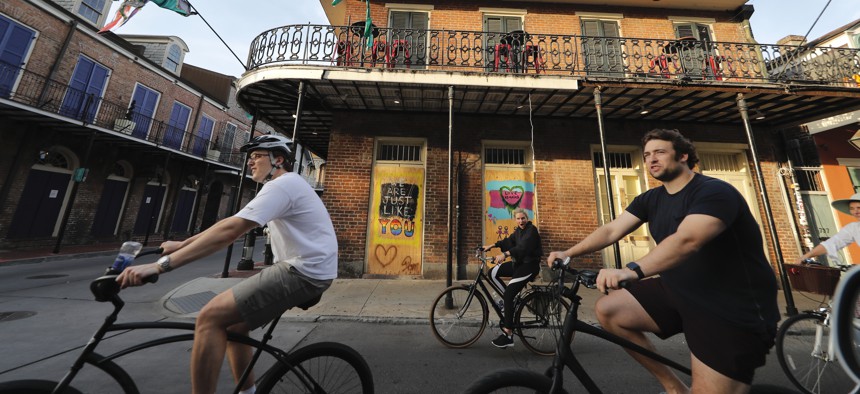Wish You Were Here: States to Use Federal Funds to Boost Tourism

People ride bikes through the largely shuttered French Quarter of New Orleans, Tuesday, May 12, 2020. Attempts to curb the spread of COVID-19 have visited an economic whammy on the state as oil prices have plummeted and tourism has dried up. AP Photo/Gerald Herbert
Governments can appropriate American Rescue Plan dollars to help the travel and hospitality industries rebound from economic devastation brought by the pandemic.
States are restarting their economic engines this summer and several are planning to use federal stimulus dollars to help bring back tourists.
Travel spending in the United States fell significantly in 2020 because of the pandemic—spending on business travel alone plummeted 70% and is estimated to take four years to fully recover. Now tourism-dependent states are hoping to make up the lost revenue by aiding affected industries and launching new advertising campaigns to attract visitors.
Under the American Rescue Plan Act, which provides state and local governments with $350 billion in direct aid, officials can use the money to help industries impacted by the pandemic, specifically the tourism, travel and hospitality sectors. State budget proposals have started to reflect the influx of federal cash.
Alaska Gov. Mike Dunleavy, for example, has proposed spending 15% of the $1 billion the state will receive through the American Rescue Plan on tourism-related initiatives. Spending would include “industry relief to promote tourism and adapt services for potential loss of cruise ship season,” according to his proposal.
Florida lawmakers approved a budget that allocates $75 million to Florida’s tourism marketing agency, Visit Florida, including $25 million in ARP funds. Tourism officials there said at least one advertising initiative will include staff visits to Mexico and England to promote the state as a destination for international travelers. International travel to Florida was down almost 75% in the first quarter of 2021, according to Visit Florida.
The Louisiana governor has identified tourism as priority for ARP spending, and Lt. Gov. Billy Nungesser has touted the importance of tourism to revitalizing the state’s economy.
“We can bring back our economy by inviting our friends and families to come to Louisiana for the holidays—shop and spend that money here,” Nungesser said at a recent public appearance.
State lawmakers this month approved plans for spending $1.7 billion in federal pandemic aid, including $60 million that will be distributed as grants to local tourism agencies to help market the state as a travel destination.
Promoting Economic Recovery and Development
For states that are heavily reliant on tourism “there is spending on hospitality and tourism as a way to promote economic recovery and economic development,” said Brian Sigritz, the director of state fiscal studies for the National Association of State Budget Officers. “Supporting those industries helps the state move forward.”
It’s a sharp turnaround from the message local government officials sent last year when they cancelled state fairs, banned short-term rentals, and restricted parking and public transit in order to prevent large crowds from gathering for events.
But for states whose economies heavily rely on tourism, the pandemic created a significant revenue shortfall that state leaders want to correct.
Eighteen states saw a more than 40% decline in travel spending last year, according to Simon Hudson, a professor of tourism at the University of South Carolina’s College of Hospitality, Retail and Sport Management. Hawaii experienced the biggest decline—a spending drop of 60%.
Deciding how to spend ARP funds will likely be a multiyear process, given how the funds will be distributed in separate tranches, Sigritz said. Of the states that are spending federal funds to aid the tourism industry, Sigritz noted that past allocations (through the CARES Act or other federal aid) have tended to support workers or companies that lost business as a result of the pandemic.
But the timing of the ARP funding may allow states “to be more forward looking,” he said, noting that there has been more discussion of using the money to invest in programs that can sustain state economies or grow local industries.
Andrea Noble is a staff correspondent with Route Fifty.
NEXT STORY: Rental Prices are Booming in Mid-Sized Cities





